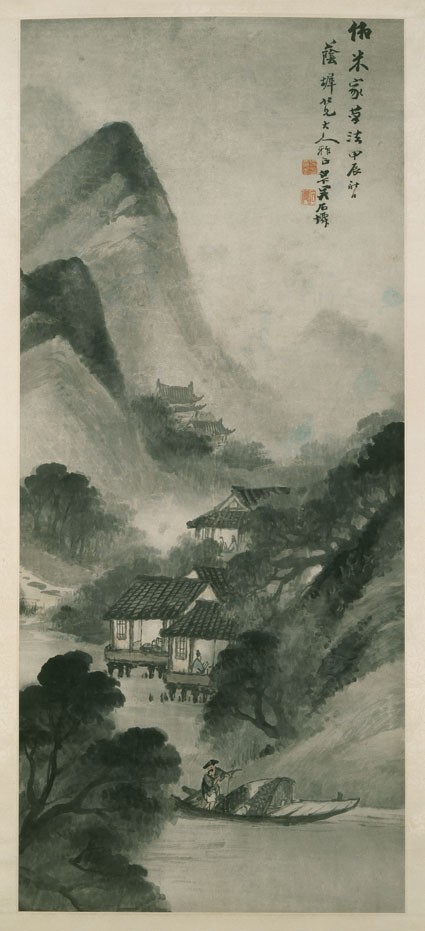Chinese Landscapes from the Ashmolean Collection
(from 9th Feb until 21st Jul 2013)Explore the continued tradition of Chinese landscape painting in this complement to the Xu Bing show.

- Reference URL
Actions
Mountain landscape with a figure in a boat
-
Description
Wu Qingyun was from Nanjing, but lived and worked mostly in Shanghai, and also spent some time in Japan. He is considered by some to have developed Western stylistic features in his paintings, most evident in his use of chiaroscuro. This, however, might instead be the influence of the early Qing dynasty (1644-1911) painter Gong Xian (1618-1689) from Nanjing.
Wu Qingyun is known for imitating the works of Mi Fu (1051-1107), the master calligrapher and landscape painter from the Song dynasty (AD 960-1279). Mi Fu's landscapes always depict the cloudy and misty hills of the Jiangnan region in South China through large wet dots of ink. In this painting, the artist inscribes how he is ‘Imitating the brushwork of Mi Fu’.
-
Details
- Associated place
- Date
- August - November 1904
- Artist/maker
-
Wu Qingyun (before 1857 - 1916) (artist)style of Mi Fu (1051 - 1107) (artist)
- Associated people
-
possibly Li Dianlin (1842 - 1917) (recipient)
- Material and technique
- ink and slight colour on paper
- Dimensions
- 132.08 x 63.5 cm (height x width)
- Material index
- Technique index
- Object type index
- No. of items
- 1
- Credit line
- Purchased, 1963.
- Accession no.
- EA1963.2
-
Further reading
Vainker, Shelagh, Chinese Paintings in the Ashmolean Museum, Oxford (Oxford: Ashmolean Museum, 2000), no. 140 on p. 164, illus. p. 165 fig. 140
Past Exhibition
see (1)Location
-
- currently in research collection
Objects are sometimes moved to a different location. Our object location data is usually updated on a monthly basis. Contact the Jameel Study Centre if you are planning to visit the museum to see a particular object on display, or would like to arrange an appointment to see an object in our reserve collections.
Publications online
-

Chinese Paintings in the Ashmolean Museum, Oxford
The year of Wu Qingyun's birth is unknown, though his earliest dated work is from 1857. He was from Nanjing, but lived and worked mostly in Shanghai. He spent some time in Japan and is considered by some to have developed Western stylistic features in his paintings. This is evident more in his use of chiaroscuro, in which he may anwyay be indebted to the earlier Qing Nanjing painter Gong Xian, than in any use of perspective.
Notice
Objects from past exhibitions may have now returned to our stores or a lender. Click into an individual object record to confirm whether or not an object is currently on display. Our object location data is usually updated on a monthly basis, so please contact the Jameel Study Centre if you are planning to visit the museum to see a particular Eastern Art object.
© 2013 University of Oxford - Ashmolean Museum


